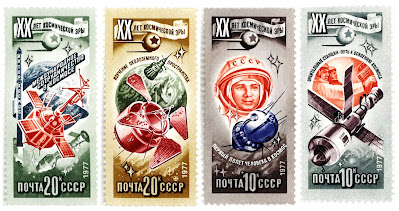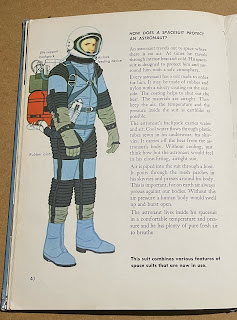While I was at primary school, I would always visit the library, both the school one and the civic one nearby. It was through these institutions that I developed my love of space books and found items that I would eventually add to my own collection, many years later. The little library in the school wasn’t well stocked but did have its share of space books, which I examined closely. Most were from the late fifties and early sixties and quite dry, text heavy editions, but now and again I would find a more colourful and engaging read.
The Golden Library of Knowledge series were one such example. A series of educational textbooks produced under the watchful eye of one Dr Herbert Zim and published by the Golden Press in New York. the series covered nature, space, dinosaurs, animals and science in a collection of small hardback books. Each one was beautifully illustrated and dated from 1959 to about 1961. Two editions caught my eye, the Moon and Space Flight.
‘The Moon - Our Nearest Neighbour’ is a look at what was known about Luna, prior to the moon landings, with lots of astronomical data and maps made by terrestrial telescopes, plus current theory on how the satellite came to be.
The majority of the imagery are painted illustrations by George Solonevich, with one or two diagrams by John Polgreen.
The book also includes some telescope imagery of craters and seas, as at the time of publication, no successful probe had been able to photograph the surface clearly.
As usual, towards the end we have a vision of future missions and some skeletal spaceships with large exposed tanks heading for the surface.
Solonevich’s final illustration is a grand vista of lunar mountains, with a recessed moonbase tucked away in the crater depths and a spaceship lifting off. Solonevich’s technique here is to use thick impasto paint to achieve the rough lunar terrain, which is quite effective.

Next in the same series is an all time favourite of mine, that I originally discovered on the school bookshelf and bought from America decades later. ‘Space Flight’ is a total departure from its contemporary books, as rather show the dull, technical side of space travel, it displays a much more romantic, adventurous view. Written by noted science fiction author and editor Lester Del Rey and illustrated by John Polgreen. It is Polgreens artwork that makes the book stand out for me, as his simple painted artwork, with lush pastel tones lend the illustrations an ethereal and distinct look, which is not found anywhere else.
The spacecraft and suits in the book follow Werner von Brauns concepts for astronauts and rockets, with the spacemen clad in solid claw fingered suits, or jetting about in cylindrical ‘space taxis’.
The main spaceships are very much Braunian, with long conical bodies and delta wings. Polgreen keeps the designs very simple, but his paintings always have a certain light to them, which show them off in delightful colour, as if we are seeing them at an evening landing or a sunset launch.
Equally, his space themed paintings are brilliant and colourful, with stations and spaceships gently reflecting a pale blue earthlight. All his vehicle designs are simple and elegant, using platonic solids such as spheres and cylinders and cones, but still managing to portray believable and exciting looking craft.
To compliment the simple layouts, Polgreen includes some excellent detailed cut aways and diagrams.
The 'Moon Observer' is a classic example of ship design, whereas other artists might have been tempted to add panel detail or antennae, Polgreen's craft is a simple train of pastel solids.
Even the planetary probe at the end of the book has a very reserved look and has instruments and aerials kept to an absolute minimum.
Odhams published a book in 1968, which used John Polgreens paintings much more extensively, giving him credit on the title too.
Whilst not part of the Golden Library series, it is a much larger hardback, but set out in more of a guidebook style, with question and answer style entries.
It includes a mixture of photographic reference, still pre-moon landing and some more of Polgreens glorious painted artwork.
Polgreen almost rivals Chesney Bonestell for his renditions of lunar and planetary landscapes, favouring a pale blue cast to the mountains.
Published in 1968, the depictions of the Apollo Lunar Excursion Module and EVA suits are still in the conceptual phase, although his depictions of the Gemini vehicle are very accurate.
The book is rounded off with a beautiful vista of a wheel type platform serenely orbiting Earth, once more finished in the ethereal blue glow.
























































